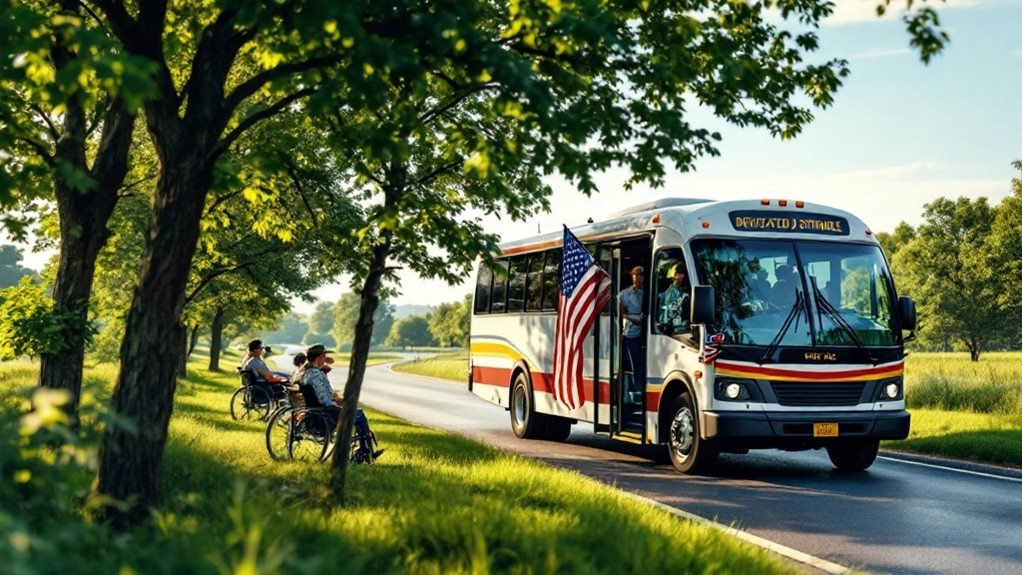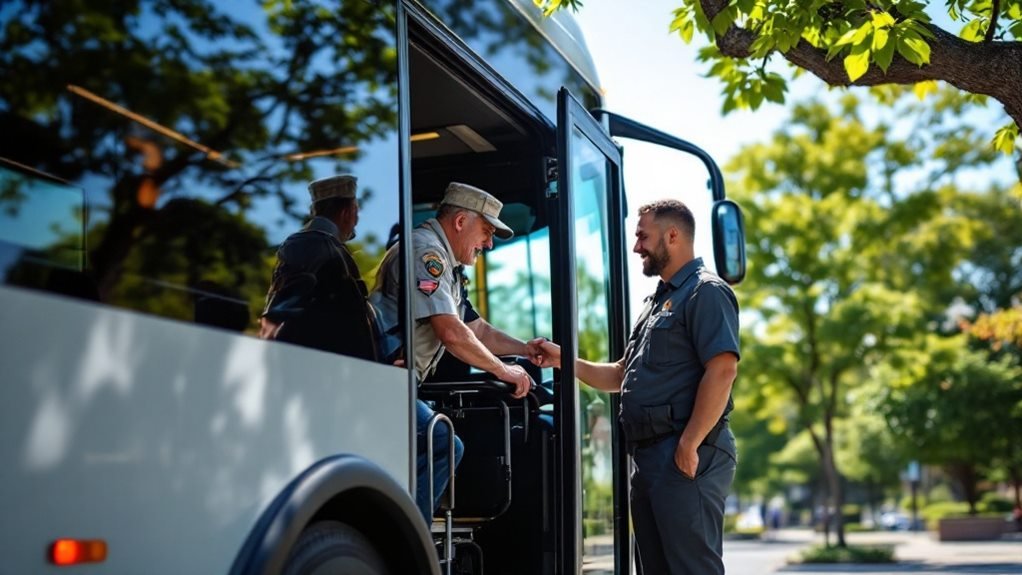Starting a transport business for veterans is an exciting opportunity to cater to a community that truly appreciates specialized care. First, let's assess the market demand by understanding our veteran community's needs and identifying underserved areas. Developing a business plan helps articulate our mission, analyze competition, and create effective marketing strategies. Securing funding options, like grants and veteran-specific loans, is essential for managing startup costs. We must also obtain necessary licenses and guarantee compliance to build credibility. Finally, building a strong network with local businesses and veteran organizations strengthens our foundation. As we explore these steps further, we'll uncover valuable insights to guide our journey.
Key Takeaways
- Conduct market research to understand veterans' unique transportation needs and identify underserved areas.
- Develop a comprehensive business plan focusing on reliability, empathy, and trust within the veteran community.
- Secure funding through veteran-specific grants and loan programs to support startup costs.
- Obtain necessary transportation licenses, ensuring accuracy and completeness to avoid delays.
- Build a strong network by connecting with veterans and local businesses for support and partnership opportunities.
Assess the Market Demand
When we consider starting a transport business for veterans, evaluating market demand is vital. Understanding the needs of our veteran community allows us to tailor services that truly make a difference. We begin by examining current market trends. Is there a growing demand for specialized transportation services? Are veterans often underserved in this area? By analyzing these patterns, we can gauge the potential success of our venture.
Next, let's explore customer demographics. Veterans span various age groups, from young individuals returning from recent service to older veterans who may need more assistance. Each group has unique transportation needs. For example, younger veterans might require transportation to job interviews or educational facilities, while older veterans might need help reaching medical appointments or social activities. Identifying these demographics helps us customize our offerings to serve them better.
In our pursuit to serve those who've served us, it's imperative we align our business model with these insights. By staying informed and responsive to market trends and customer demographics, we can guarantee our transport business not only thrives but also profoundly impacts the lives of veterans in our community.
Together, we can create a supportive and efficient service.
Develop a Business Plan
As we commence on developing a business plan for our transport service aimed at veterans, it's vital to outline our objectives and strategies with precision. Our target audience consists of those who've served, and understanding their unique needs will be our guiding star.
We'll start by clearly defining our mission: providing reliable and comfortable transport solutions that honor their service. This clarity will guide every decision we make.
Next, conducting a competitive analysis is important. We must assess existing services in our area, identifying both their strengths and gaps. By understanding where others succeed or fall short, we can carve out our niche, ensuring our offerings are both unique and valuable.
Our focus should remain on quality and empathy, building trust within our community.
We'll also outline our marketing strategies, emphasizing our commitment to serving veterans. Crafting messages that resonate with our audience's values and experiences will be key.
In addition, we'll set measurable goals, allowing us to track progress and make necessary adjustments. Through careful planning and a focus on our target audience, we can build a transport business that truly serves those who've served us.
Secure Funding Options
Having established a solid business plan, it's now important to explore funding options to bring our vision to life. As veterans, we're uniquely positioned to access various grants opportunities and loan programs designed to support us in our entrepreneurial journey.
It's vital to research these resources meticulously to find the best fit for our transport business.
Let's start by examining grants opportunities specifically available for veterans. Organizations like the U.S. Small Business Administration (SBA) offer veteran-focused grants that can provide the necessary capital without the burden of repayment.
These grants not only help finance our startup costs but also demonstrate our commitment to serving our communities.
In addition, we should consider loan programs tailored for veterans. The SBA and other financial institutions offer favorable terms through programs like the Veterans Advantage Loans, which can provide the flexibility needed to manage our business expenses effectively.
Obtain Necessary Licenses
Maneuvering the process of obtaining necessary licenses is an essential step in launching our transport business successfully. As veterans, our commitment to service can seamlessly shift into a transport venture, but ensuring we've the proper licenses is critical.
First, we need to identify the specific license types required for our business model. Whether it's a commercial driver's license (CDL) for operating larger vehicles or a motor carrier operating authority for interstate transport, each has unique requirements.
Once we've pinpointed the needed license types, let's focus on the application process. We should begin by gathering all necessary documentation, such as proof of insurance, vehicle registrations, and any health certifications.
It's imperative to be thorough and organized, as missing paperwork can delay approval. Most importantly, we should review each application carefully, ensuring all information is accurate and complete.
As we navigate these steps, let's remember that persistence and attention to detail are our allies. Obtaining the right licenses not only keeps us compliant with regulations but also builds credibility with our clients.
Build a Strong Network
With our licenses in hand, it's time to focus on building a strong network that will support our transport business. Networking strategies are essential to our success, and they start with reaching out to fellow veterans and local businesses. By attending veteran-focused events or joining organizations that cater to veterans, we can connect with people who share our values and understand our mission. This approach not only builds camaraderie but also opens doors to partnership opportunities.
We should also consider leveraging social media platforms and online forums where industry professionals gather. Engaging in these spaces allows us to share our expertise, learn from others, and stay informed about industry trends. Remember, every conversation is a chance to expand our network and discover new opportunities.
As we network, let's focus on building relationships based on mutual respect and shared goals. We can explore partnership opportunities with other transport businesses, logistics companies, or even local governments.
These partnerships can lead to joint ventures, shared resources, or simply valuable advice. By nurturing these connections, we're not only strengthening our network but also reinforcing our commitment to serving others and ensuring the success of our transport business.
Conclusion
In wrapping up, we've journeyed through the essential steps to kickstart a transport business tailored for veterans. By evaluating market demand, crafting a solid business plan, securing funding, obtaining licenses, and building a strong network, we're setting ourselves up for success. Remember, Rome wasn't built in a day, but with dedication and the right strategies, we'll be on the road to creating a thriving venture that supports and empowers our fellow veterans. Let's hit the ground running!



